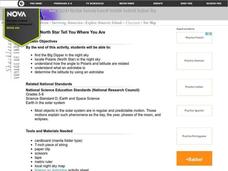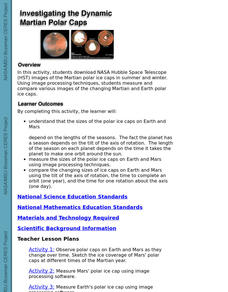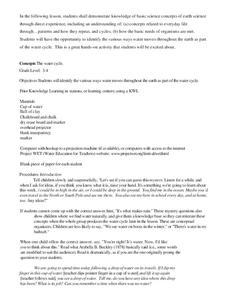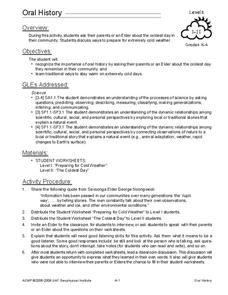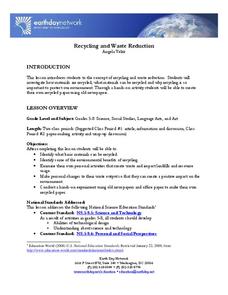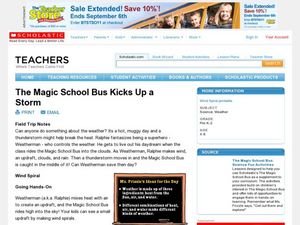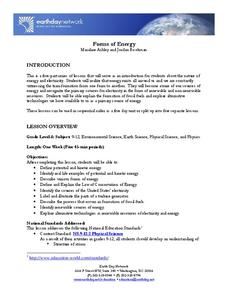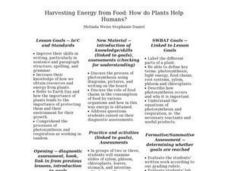Curated OER
Energy Defined
Fourth graders complete activities to study the sources of energy and forms. In this energy activity, 4th graders discuss the origin of energy and define it. Students participate in several experiments to further study energy including a...
Curated OER
The Flat Stanley Project
Learners read the book Flat Stanley. In this environmental stewardship lesson, students participate in earth-friendly activities based upon the book. This lesson includes ideas such as using recycled paper to make a "paper pal."
Curated OER
The Joy of a Garden
Young scholars study environmental stewardship. In this environmental stewardship lesson, students read the story The Gardner and define the character's actions for the environment. Young scholars define philanthropy and complete a...
Curated OER
Investigating Leaves Through Printmaking
Students create leaf rubbings as they study the parts of a leaf. They describe the leaves and chart their observations.
Curated OER
Greenhouse Gases: The Chemistry Behind the Culprits
Ninth graders investigate the effect of different gases in the atmosphere. In this chemistry activity, 9th graders explain how these gases contribute to global warming. They suggest possible solutions to this growing problem.
Curated OER
Let the North Star Tell You Where You Are
Students participate in activities in which they find the Big Dipper and locate the North Star in the night sky, examine the relationship between the angle to Polaris and latitude, and determine latitude by using an astrolabe.
Curated OER
Investigating the Dynamic Martian Polar Caps
Students download NASA Hubble Space Telescope images of the Martian polar ice caps in summer and winter, and measure and compare various images of the changing Martian and Earth polar ice caps.
Curated OER
The Water Cycle
Students access prior knowledge of the water cycle by completing a KWL. In this water cycle lesson plan, students follow the movement of water through the water cycle.
Curated OER
Oral History
Students interview a Native Elder to learn about oral history and cold weather. In this weather activity, students ask an Elder about the coldest day they remember in their community and complete two worksheets for the topic.
Curated OER
Recycling and Waste Reduction
Young scholars investigate recycling and waste reduction and its positive impact on the environment. In this environmental science lesson plan, students determine how and why materials are recycled. They apply their knowledge...
Curated OER
Habitat Collage
Students explore habitats. In this science lesson, students discuss habitats and the insects that are found within each habitat. Students create a habitat collage.
Curated OER
The Magic School Bus Kicks Up a Storm
Students investigate how warm air from a lamp affects a spiral of paper. They determine how the warm air rises while cooler air moves into take its place which creates wind in this Magic School Bus activity.
National Geographic
Expedition Clothing Then and Now
Introduce your class to the Everest expedition to reenact a 1924 climb by George Mallory and Andrew Irvine. Discuss and show pictures of the types of clothing worn at that time and compare it to today's state-of-the-art climbing gear....
Curated OER
What Is Natural?
Your junior highers will learn about which objects are natural and classify objects as abiotic or biotic. Your class will trace human products to their natural resources using matter cycles and then create their own definition of nature.
Captain Planet Foundation
Energy Flow in the Garden
How can you tell what an owl has eaten? Study the food chain and flow of energy in an ecosystem by dissecting an owl pellet and noting the bones found inside. Additionally, the lesson includes a game about consumers and producers with a...
Curated OER
The Battle for Ultimate Power
Students gain an understanding of how the powers of 10 and scientific notation can be used to represent the scale of things in the universe. They relate the number of stars in the universe to the number of grains of sand on Earth's beaches.
Earth Day Network
Forms of Energy
Give me a home where electric buffalo roam and I'll show you an ohm on the range. Introduction your classes to potential and kinetic energy, electricity, and renewable resources with a resource that combines observation, direct...
Curated OER
All in the Family: Calculating Cousins
Learners view pictures of distant "cousins" to humans. They place them in order by their distance from humans. Students receive a packet of six pages featuring graphics and a cousins summary page. They work in groups to complete 5 cousin...
Curated OER
Will There Be a White Christmas This Year?
Students examine historical weather data, and create map and color key that illustrates the likelihood of a white Christmas in different locations across the United States.
Teach Engineering
The Amazing Red Planet
Introduce your class to Mars with a resource that provides information about its size, location, length of day, length of year, number of moons, and average temperature. Also includes is information about the lans for past...
Curated OER
Harvesting Energy from Food: How do Plants Help Humans?
Beginning botanists view slides of plant vascular tissue. They watch Magic School Bus Gets Planted, which you can find online, and then write a summary of what they have learned about plants. This instructional activity could be used...
Curated OER
Shadow Trackers: From Photography to Writing
Students explore the rotation of the earth. In this science lesson, students view photos of various places around the world. Students conduct an experiment in which they can see how the earth's rotation creates shadows on the earth.
Curated OER
It's Hot
Third graders examine the effect of sunlight on the earth. Individually, they pick an article of clothing out of a bag and sort themselves based on the color of the shirt and whether it should be worn on a cold or a hot day. To end the...
Curated OER
How Far Away is SOHO?
Students create a scale model of the Earth and the sun that demonstrates where the SOHO satellite is in relation to the Earth.







